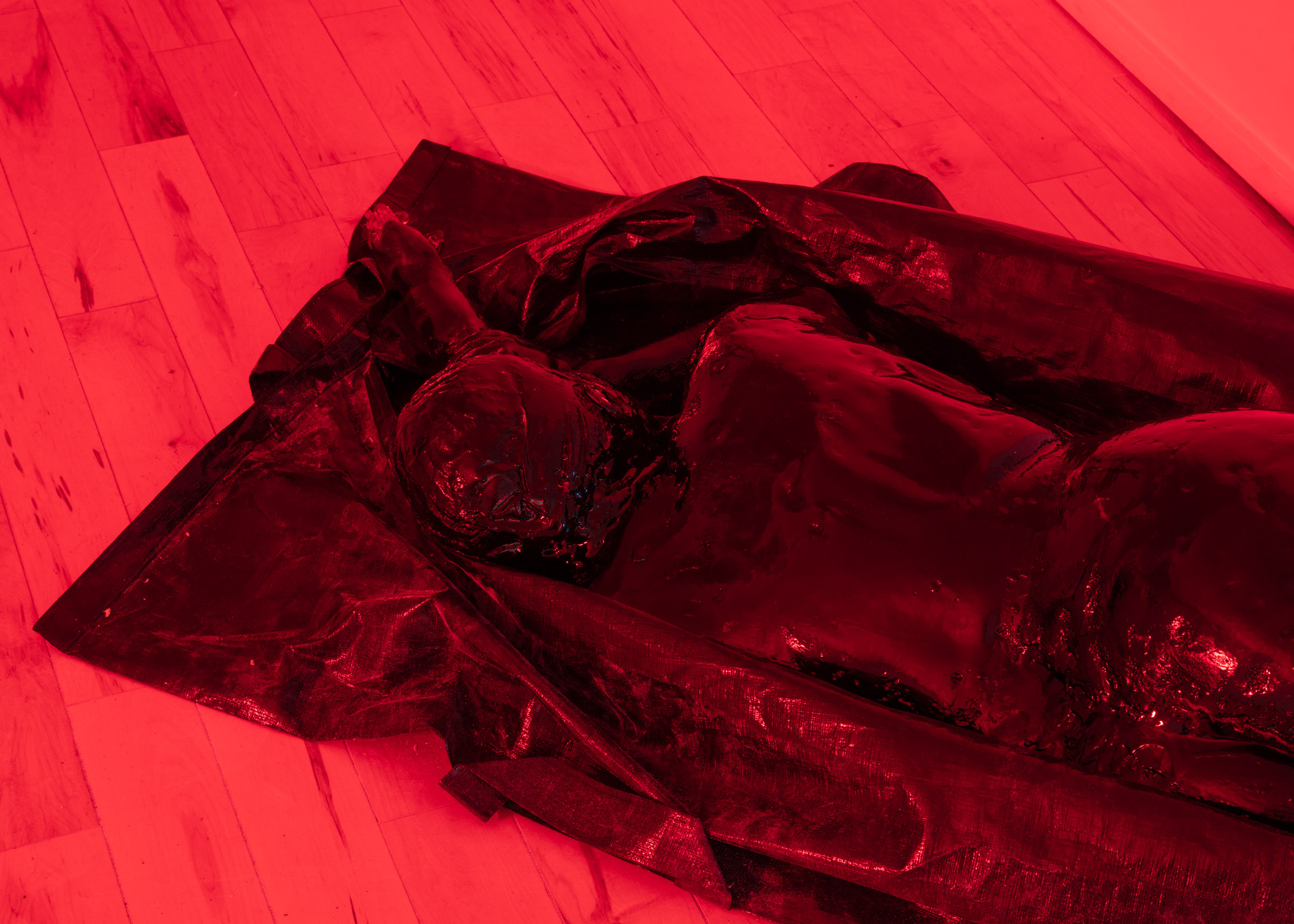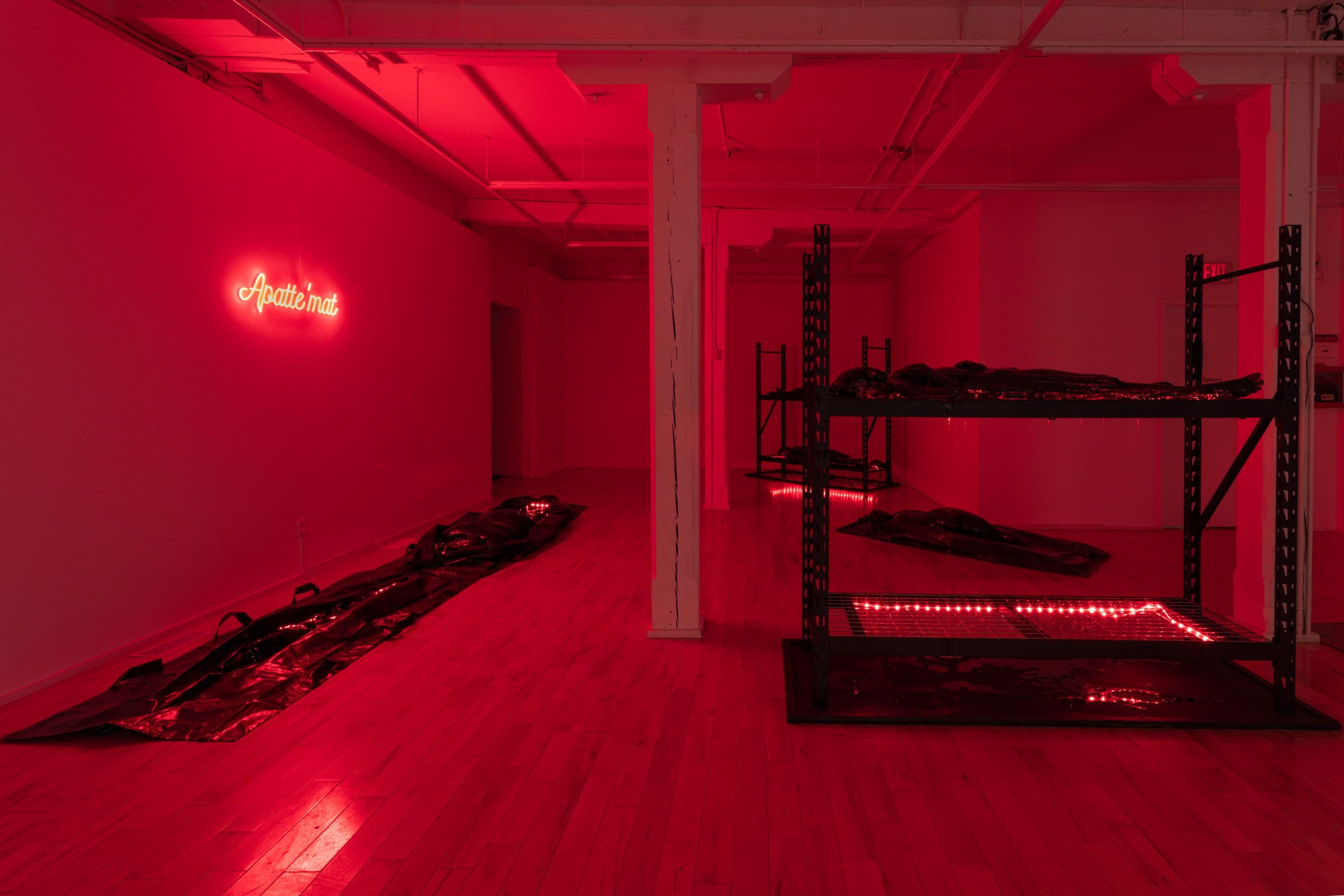Npuinu ên·pu·i·nu- "Corpse", 2021
![]()
Npuinu ên·pu·i·nu- "Corpse", 2021

Installation at the Visual Arts Center of Clarington:
n







Npuinu ên·pu·i·nu- "Corpse", 2021, refined sugar, dimensions variable.
These sugar-casted ambered bodies reflect the relationship between BIPOC people, sex work, fetishization, and community care. By creating edible sugar casts from specifically BIPOC women and trans folk, the work references the exotification of diverse people to fulfill colonial appetites, reducing human identity to an object of desire. This body of work addresses loss but at the same time showcases care, ancestry and a taking back of both the body and sexual agency - taking back our bodies - no shame, just perfection in each pose.
These bodies are composed of many accumulated sugar layers that speak to several familial, ancestral, and geological constitutions. Each corpse’s built-up sugar sheeting is inspired by geologic “hoodoos” (earth pyramids). These ancient, tall spires of rock protrude from the bottom of badlands and consist of sedimentary rock layers built-up over millennia. By aesthetically referencing this metamorphic process, the sculptures nod towards Indigenous People’s longstanding lineage and relationship to land; both built upon many earlier layers of human and environmental history preceding colonization.
The corresponding neon piece spells out “Apatte'mat” which translates to, “win back a loss” In Mi’kmaq and aesthetically references red-light districts. The work expands on the notion of care and love, with the spilling out of red neon light that touches the gloss and curve of each body with a red glow, giving light to these spirits. Within this installation, the colour red can be misunderstood by colonial setter populations as something sinister and harmful. However, the colour red has many other meanings for Indigenous Peoples within the Mi’Kmaq medicine wheel such as the earth, the physical body, and birth/ rebirth. It touches on the balance of the world around us, referencing healing and community care.
This project could not have been made possible without the funding from The Canada Coucil for the Arts and the Alberta Foundation of the Arts
A huge thanks to all the follk involved in making this peroject happen The amazing sudio assistants: Jamie La Rose, Shabnam Afrand, Daniela Casas, Jihee Min, Anelia Victor and Kit MacNeil
These sugar-casted ambered bodies reflect the relationship between BIPOC people, sex work, fetishization, and community care. By creating edible sugar casts from specifically BIPOC women and trans folk, the work references the exotification of diverse people to fulfill colonial appetites, reducing human identity to an object of desire. This body of work addresses loss but at the same time showcases care, ancestry and a taking back of both the body and sexual agency - taking back our bodies - no shame, just perfection in each pose.
These bodies are composed of many accumulated sugar layers that speak to several familial, ancestral, and geological constitutions. Each corpse’s built-up sugar sheeting is inspired by geologic “hoodoos” (earth pyramids). These ancient, tall spires of rock protrude from the bottom of badlands and consist of sedimentary rock layers built-up over millennia. By aesthetically referencing this metamorphic process, the sculptures nod towards Indigenous People’s longstanding lineage and relationship to land; both built upon many earlier layers of human and environmental history preceding colonization.
The corresponding neon piece spells out “Apatte'mat” which translates to, “win back a loss” In Mi’kmaq and aesthetically references red-light districts. The work expands on the notion of care and love, with the spilling out of red neon light that touches the gloss and curve of each body with a red glow, giving light to these spirits. Within this installation, the colour red can be misunderstood by colonial setter populations as something sinister and harmful. However, the colour red has many other meanings for Indigenous Peoples within the Mi’Kmaq medicine wheel such as the earth, the physical body, and birth/ rebirth. It touches on the balance of the world around us, referencing healing and community care.
This project could not have been made possible without the funding from The Canada Coucil for the Arts and the Alberta Foundation of the Arts
A huge thanks to all the follk involved in making this peroject happen The amazing sudio assistants: Jamie La Rose, Shabnam Afrand, Daniela Casas, Jihee Min, Anelia Victor and Kit MacNeil
Installation at the Mackenzie Art Gallery, Curated by Felicia Gay


And a huge thank you to the amazing models who trusted our team:
Amera Lebelle, Shabnam Afand, Faitmah Young, Pearlic Leng, Vada Sitaram, Kaitlyn Hollander, Shaune Smith
